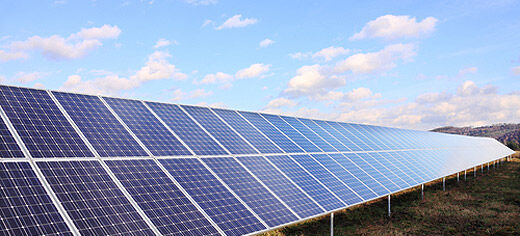
Climate change will increase the amount of electricity generated by solar power in some parts of the world while decreasing it in others.
The University of Leeds findings, published in the journal Energy and Environmental Science, have major impacts for countries looking at what type of solar power to build, where to build it and financial rates of return. One of the study's authors, Professor Piers Forster from the School of Earth and Environment, said: "Climate models are now good enough for making continental scale predictions of several types of change, making them an increasingly useful tool for developing adaption strategies."
The study showed that projected changes in temperature and insolation (sunlight) during 2010-2080 will affect two fast-growing solar technologies: concentrated solar power (CSP) and photovoltaics (PV). For Europe, there were positive results for both photovoltaics and CSP outputs.
Dr Rolf Crook from the Energy and Resources Research Institute, another of the study's authors, said the relative contribution from changes in insolation and temperature to changes in solar power output depended on the location - for example, in Europe the increased output is largely caused by increased insolation. In mainland Europe, outputs of CSP, an industry-scale solar power that uses mirrors to focus large amounts of sunlight on a small area, will increase by about 10% (5.5% in the UK).
Outputs of PV, large flat panels that convert sunlight directly into electricity, will increase in mainland Europe by about 3.5% (1.2% in the UK), the study found. In other parts of the world, PV output will increase by a few percent in China, see little change in Algeria and Australia, and decrease by a few percent in western USA and Saudi Arabia.
CSP output will increase by several percent in China and a few percent in Algeria and Australia, and decrease by a few percent in western USA and Saudi Arabia. Even an increase of a few percent in CSP outputs in North Africa could have substantial benefits for the two billion euro Desertec (EU-MENA) project, the world's most ambitious solar power plant, incorporating CSP, PV and wind technology across 12 sq kilometres. Desertec aims to provide half the electricity used by Europe, the Middle East and northern Africa by 2050. Building work is due to start next year in Morocco.
A similar concept has been proposed for Australia and Asia. The study found CSP is more sensitive to climate change than PV. Dr Crook said the findings would be significant as solar power increasingly contributed to electricity generation in a low-carbon economy. The findings come at the same time the government withdraws subsidies for households planning to install PV solar panels.
Dr Crook said: "We have shown, perhaps surprisingly, that climate change will have a positive impact on the output of solar power plants in many parts of the world. This further strengthens the case for research and investment in solar power today. Subsidies play a vital role in driving down the cost of solar technology. Cutting subsidies would only have a negative effect." Regions were selected for the study on account of existing or planned large PV or CSP solar power plants.
The findings are linked only to climate changes impacts; whether countries own or plan to own a large or small quantity of solar power infrastructure was included in the calculations.
More information: The article Climate change impacts on future photovoltaic and concentrated solar power energy output'is published in Energy & Environmental Science [DOI: 10.1039/c1ee01495a].
For further information:
Please contact the University of Leeds Press Office on +44 (0)113 343 4031 or email pressoffice@leeds.ac.uk